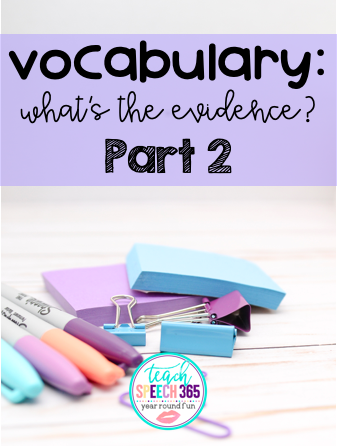Vocabulary: What’s the Evidence? Part 2

Welcome to Part 2! I’m starting this post with a statistic that I found rather astounding. Duff (2019) reported via the National Assessment of Educational Progress that “only 37% of students in the United States are considered proficient in reading by Grade 4, and 68% by Grade 8.” And as we all know, “reading comprehension and vocabulary are strongly related.”
Robust Vocabulary Instruction (RVI) is an approach outlined in a book that I read a couple years back called Bringing Words to Life. If you’re not familiar with this, I highly recommend checking it out! This article set out to see if vocabulary intervention had an effect on reading comprehension for 6th graders, using this robust vocabulary instruction approach. During the intervention period, students were exposed to the target words in at least 12 different contexts. RVI includes “repeated exposures to the word and its meaning, instruction with multiple and varied cues to word meaning, exposure to the word in multiple contexts, opportunities for deep processing, and initial presentation of the word in context.” (Duff, 2019 referencing McGregor & Duff, 2014). The article concludes that vocabulary instruction can indeed improve knowledge of vocabulary AND comprehension of texts that have the words that were taught.
Interactive book reading was the focus of the second article that I’m going to reference during this post. I’m pretty sure we do this already when we’re reading books with our students. We stop to ask questions and teach words. Children with DLD need 2-3 times as many exposures as typical peers to learn words (Storkel et. al, 2019). The major takeaway from this article was the magic number of 36. This is how many exposures were needed for children with DLD. During this study, researchers achieve 36 exposures by “providing 6 exposures to the target word during a book reading session and repeated each book reading sessions 6 times before the end of treatment.” So for the students on our caseloads who have similar profiles, we need to remember how many more exposures they need to really learn a word. I personally love to incorporate books into my speech sessions, but I think I will be more diligent about increasing the number of exposures to target words that I provide.
I don’t know about you, but it’s hard for me sometimes to read research and really figure out how to related it to my clinical practice. I’m hoping that these two blog posts have helped to provide clear, easy to understand information regarding vocabulary instruction!
Here are the articles that I referenced in this blog post:
Storkel, H. L. et al. (2019). The Impact of Dose and Dose Frequency on Word Learning by Kindergarten Children with Developmental Language Disorder During Interactive Book Reading. Language, Speech, and Hearing Services in Schools, 50, 518-539. Retrieved from https://doi.org/10.1044/2019_LSHSS-VOIA-18-0131.
Duff, D. (2019) The Effect of Vocabulary Intervention on Text Comprehension: Who Benefits? Language, Speech, and Hearing Services in Schools, 50, 562-578. Retrieved from https://doi.org/10.1044/2019_LSHSS-VOIA-18-0001.
